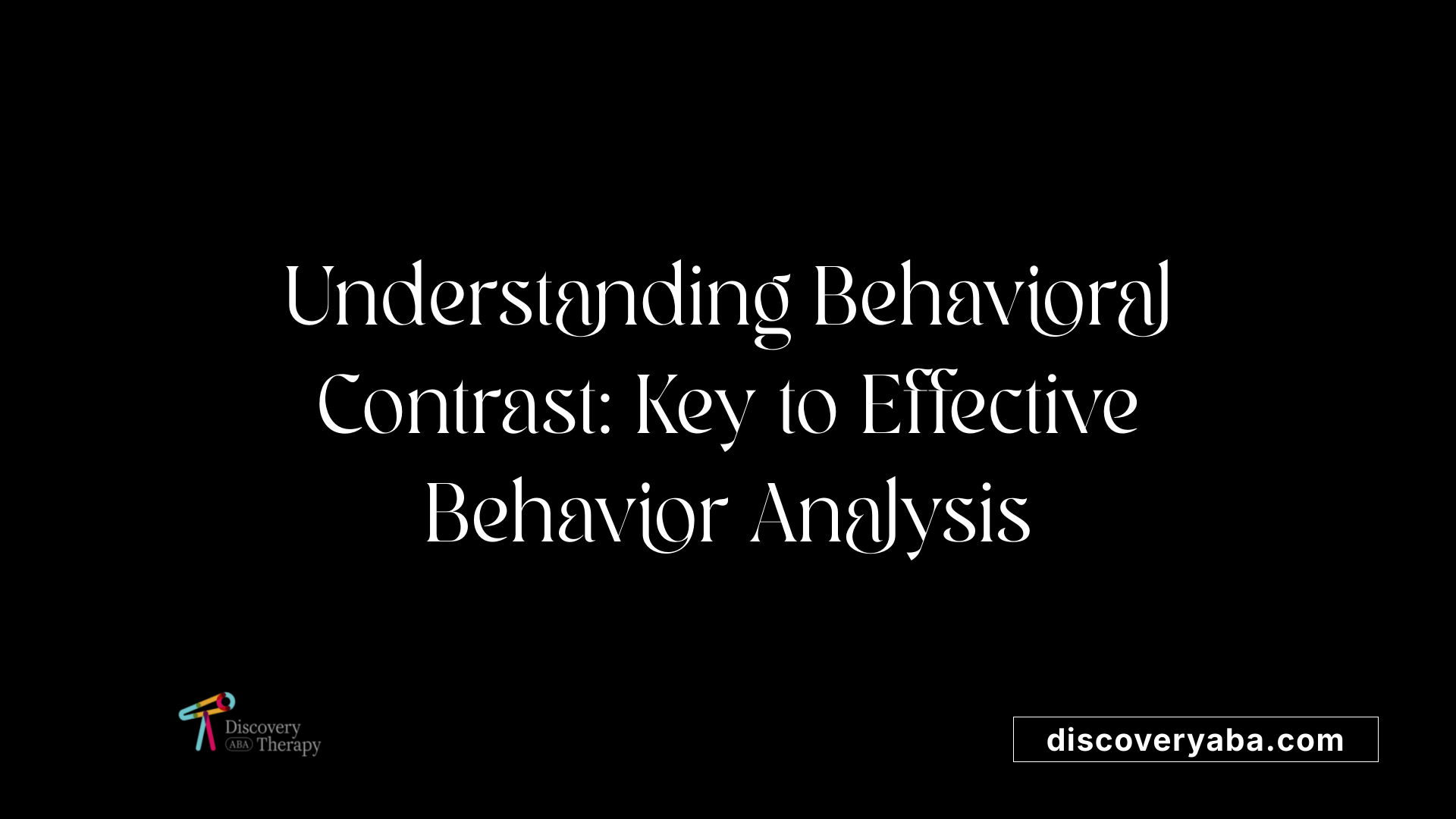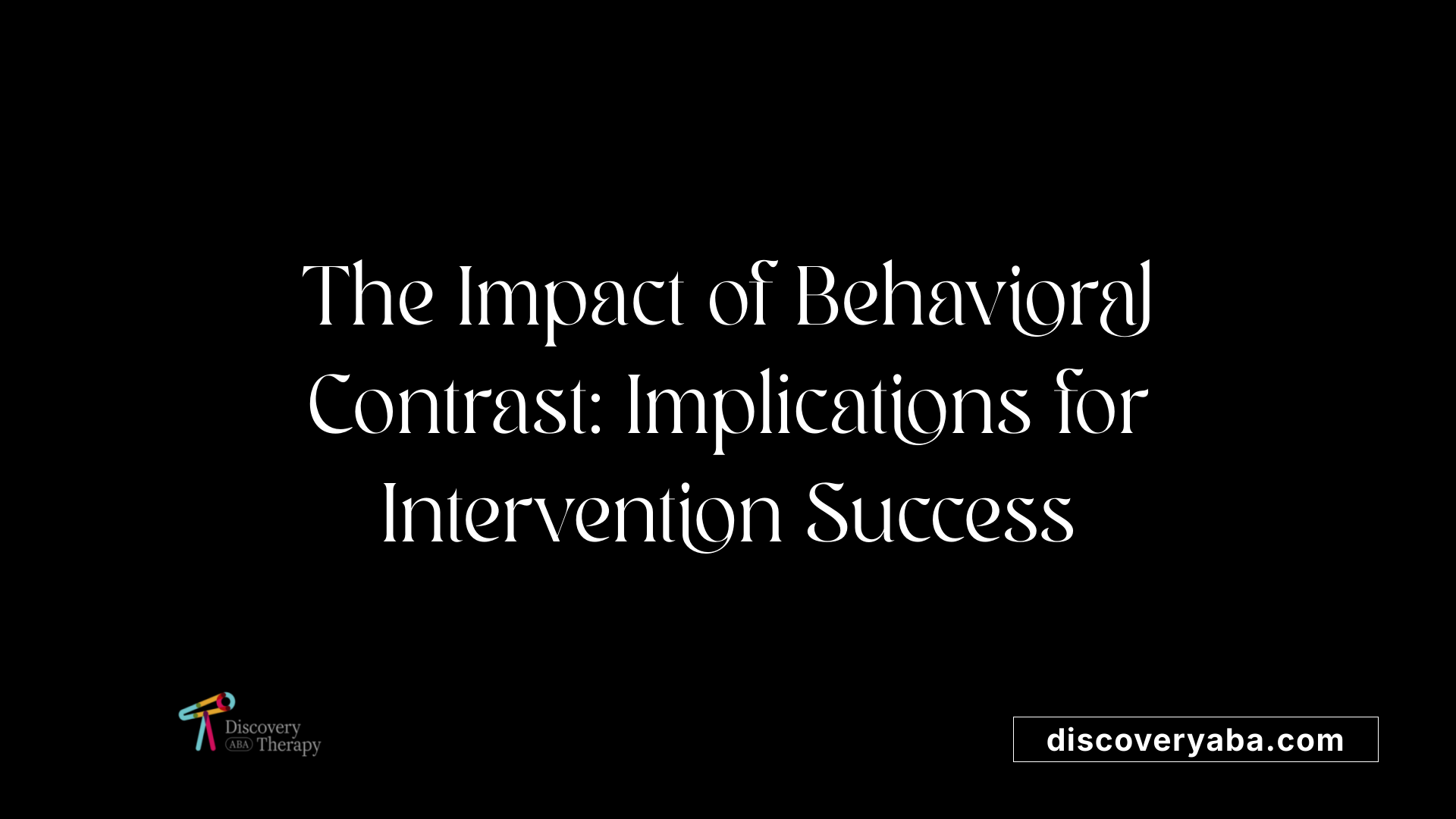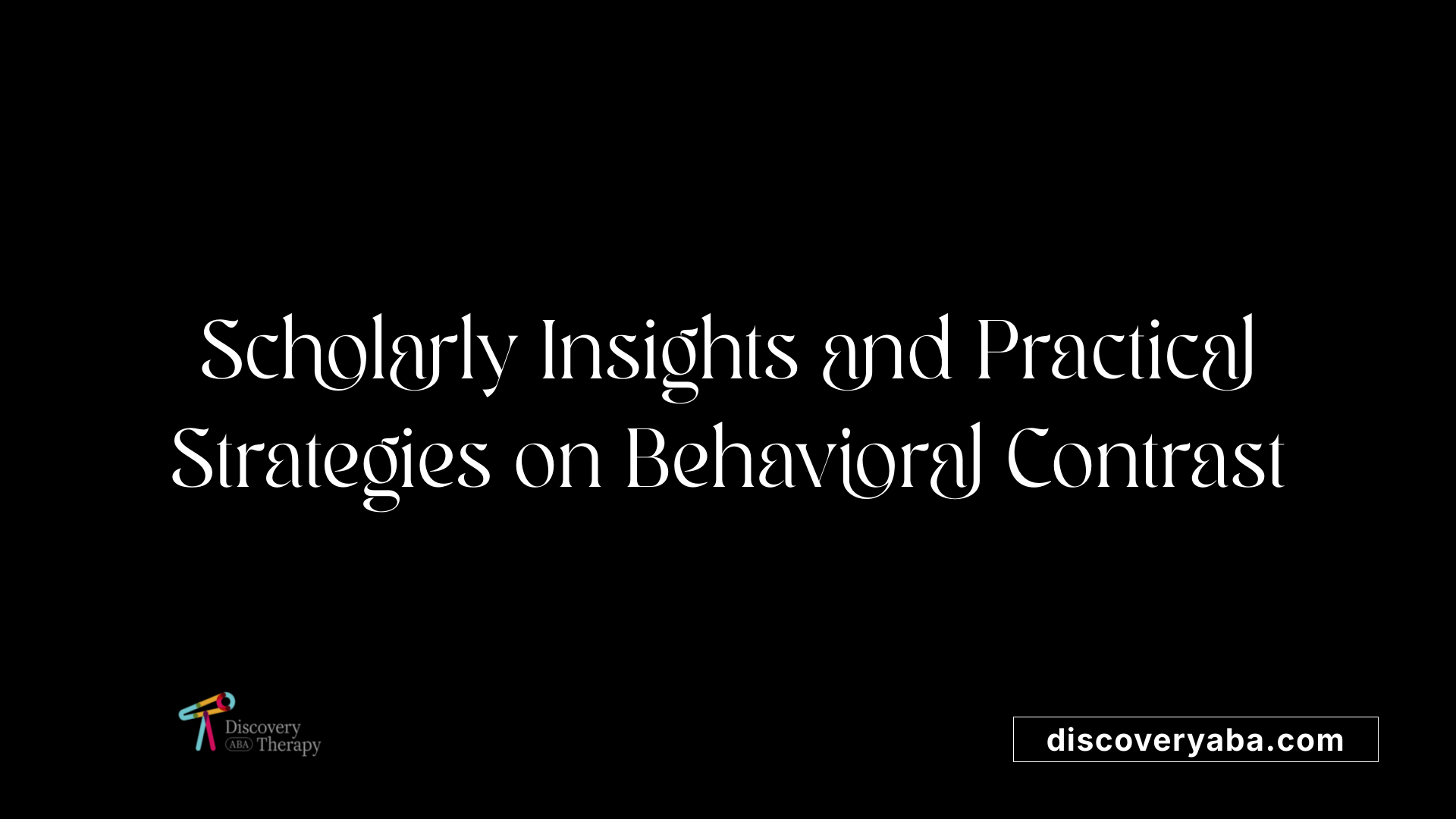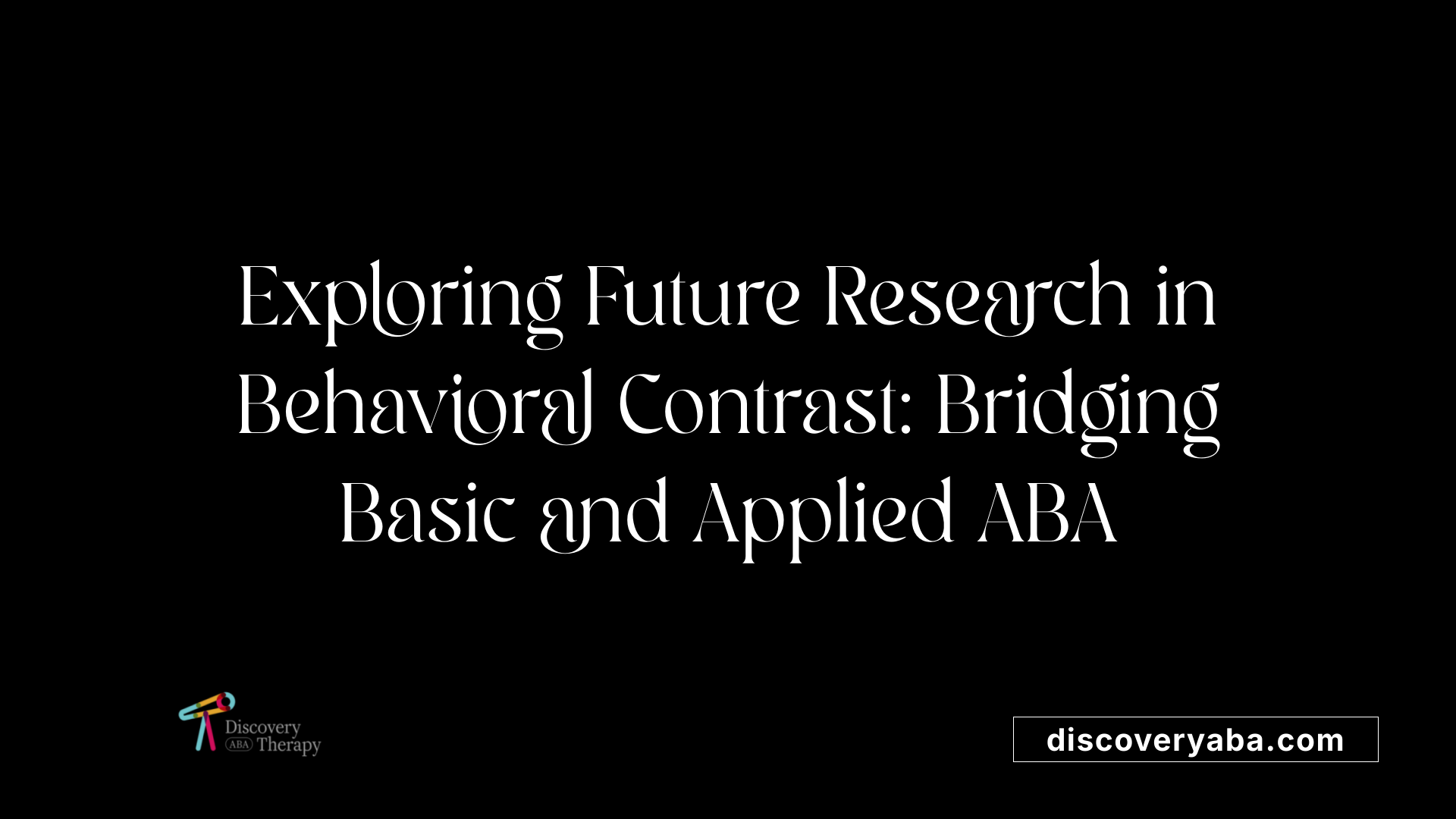What is behavioral contrast in ABA
Understanding the Dynamics of Behavioral Change Across Contexts

An Overview of Behavioral Contrast in Applied Behavior Analysis
Behavioral contrast is a critical yet complex phenomenon within the field of Applied Behavior Analysis (ABA). It describes how changes in reinforcement or punishment in one setting can elicit opposite behavioral responses elsewhere. Recognizing and understanding behavioral contrast is essential for designing effective interventions and ensuring the generalization of learned behaviors across environments.
Defining Behavioral Contrast

What is behavioral contrast in ABA?
Behavioral contrast is a phenomenon observed in applied behavior analysis (ABA) where a change in reinforcement or punishment conditions in one behavioral setting leads to an opposite change in behavior in another setting. It often occurs in situations involving multiple schedules of reinforcement or punishment. When the reinforcement schedule in one part of a multiple schedule is altered—such as increasing or decreasing reinforcement—the behavior in that setting may increase or decrease accordingly. Simultaneously, the behavior in a different, unaffected part tends to change in the opposite direction.
For example, consider a child who receives praise and attention when working on homework at home, which encourages more homework completion. If the reinforcement is removed or diminished at home, the child's homework completion might decrease. Conversely, the child may seek more attention or engage in more disruptive behaviors when outside of the home, reflecting an increase in behaviors due to the contrast effect.
This phenomenon can have significant implications for behavior interventions. If not carefully managed, treatments may inadvertently cause behaviors to shift across different environments, undermining the overall effectiveness of the intervention. Recognizing the potential for behavioral contrast allows practitioners to implement strategies that promote consistent, adaptive behaviors.
Historical background and terminology
The concept of behavioral contrast has roots dating back to early research in the 1940s. Crespi (1942) conducted pioneering work with rats, observing how changes in reward magnitude influenced their running speed—an effect later termed the Crespi effect. This early research laid the groundwork for understanding contrast effects, both positive and negative.
In ABA, the phenomenon is often referred to simply as 'behavioral contrast.' It describes a situation where the modification of reinforcement or punishment in one context causes an opposite behavioral change elsewhere. The terms positive contrast and negative contrast are used to differentiate between types of effects:
- Positive contrast occurs when an increase in reinforcement in one setting results in an increase in the behavior in that setting and a decrease elsewhere.
- Negative contrast happens when a reduction in reinforcement causes a decline in behavior at the location of reinforcement decrease but an increase in similar behavior in another setting.
This phenomenon has also been called the Crespi effect, highlighting its historical significance. Despite extensive basic research, applied scientists are still exploring ways to predict and control contrast effects more precisely.
Difference between positive and negative contrast
| Aspect | Positive Contrast | Negative Contrast |
|---|---|---|
| Definition | When an increase in reinforcement in one context boosts behavior there but reduces it elsewhere | When a decrease in reinforcement in one setting diminishes behavior in that context but causes an increase in another setting |
| Example | A student receives extra praise for participating in class, leading to more participation in that class but less participation in others | A child’s time-out reduces the frequency of tantrums in one setting, but the child's disruptive behaviors increase in another setting where reinforcement remains unchanged |
| Typical circumstances | Reward increase or extension of reinforcement in one setting | Reinforcement reduction or punishment in one setting leads to behavior escalation in another |
| Behavioral outcome | Opposite reaction in various settings, often in response to changes in reinforcement patterns | Consistent with the idea of contrast, where the change in reinforcement leads to opposite behaviors |
How behavioral contrast influences interventions
Behavioral contrast plays a crucial role in designing and implementing behavior modification strategies. For example, therapists might focus on teaching replacement behaviors or ensure reinforcement is consistent across environments to prevent undesirable shifts.
Strategies to mitigate adverse contrast effects include:
- Providing reinforcement across all relevant settings
- Teaching alternative, functional behaviors
- Avoiding reinforcement for problematic behaviors in only some environments
- Using schedules that promote generalization of skills
Understanding and anticipating behavioral contrast helps ensure that behavioral interventions yield consistent and socially meaningful changes across multiple contexts.
The Impact and Significance of Behavioral Contrast

How does behavioral contrast relate to reinforcement schedules?
Behavioral contrast is directly linked to how reinforcement and punishment are structured across different settings or components of a behavior schedule. It often occurs in multiple schedule arrangements, where changes in reinforcement or punishment in one part of the schedule lead to opposite responses in another. For instance, if reinforcement for a behavior is reduced in one environment, the individual might decrease the behavior there but increase it in a different setting where reinforcement remains unchanged or is increased.
This inverse relationship is seen in positive and negative contrast effects. Positive contrast happens when a response increases even when the reinforcement remains the same or decreases slightly, often after a severity reduction. Negative contrast involves a decrease in responding when rewards for a particular behavior are increased elsewhere, prompting the individual to shift responses.
Research demonstrates that adjusting the rate or duration of reinforcement can induce these contrast effects, which are crucial for shaping behavior. Understanding how reinforcement schedules influence these opposite behaviors helps clinicians and practitioners better design interventions, making behavior modification efforts more effective.
In terms of response dynamics, the interschedule definition focuses on changes in response rates when switching between different schedule components, whereas the intraschedule perspective emphasizes responding within a single schedule relative to a baseline. Both frameworks illustrate how altering reinforcement conditions in one area can produce inverse behavioral responses elsewhere, emphasizing the nuanced interplay between reinforcement schedules and behavioral outcomes.
What are examples of behavioral contrast?
Behavioral contrast manifests vividly across various settings and behaviors, often observed by practitioners and caregivers as unexpected shifts in behavior when reinforcement or punishment contingencies change.
A common example is a child who behaves differently at school versus at home. At school, the child might be less disruptive because of consistent reinforcement for good behavior and effective consequences for disruptions. However, at home, if similar rules are not enforced or consequences are inconsistent, the same child might exhibit more tantrums or non-compliance.
Another example involves reinforcement of eating behavior, such as a child who eats cookies regularly in the presence of a grandmother. When the grandmother punishes or discourages cookie eating, the child's consumption decreases during her presence. Conversely, when she is absent or less strict, the child might increase cookie intake.
Similarly, in a classroom intervention, reducing talking out of turn in mathematics class through reinforcement may lead to an increase in similar behaviors in a different subject like reading if no intervention is in place there. This shift highlights the importance of consistent reinforcement strategies across different settings.
To manage behavioral contrast effectively, practitioners recommend consistent rules, collaborative caregiver training, and teaching replacement behaviors. These steps help minimize unwanted shifts and promote stable, generalized behaviors. Recognizing that behavioral contrast can cause unintended outcomes underscores the need for comprehensive treatment planning.
How does behavioral contrast influence intervention effectiveness?
Behavioral contrast can significantly impact the success of behavioral interventions. When reinforcement or punishment is manipulated in one environment, the resulting opposite behavioral change in another setting may diminish the overall effectiveness of treatment.
For example, if an intervention successfully reduces disruptive behavior during therapy sessions, but the behavior worsens in the child's home or school environment, the true impact of the intervention is compromised. Such contrast effects can lead to inconsistent behavior patterns, making it challenging to achieve long-term, generalized improvements.
To optimize intervention effectiveness, practitioners often incorporate strategies such as teaching replacement behaviors, punishing all instances of a problematic behavior consistently, and reducing access to reinforcement for undesired behaviors across settings. These measures aim to reduce the likelihood of contrast effects sabotaging the overall goals of treatment.
What are the implications for generalization and transfer of skills?
Behavioral contrast complicates the process of skill generalization across different settings. If a child learns a new skill in therapy but the reinforcement contingencies differ significantly elsewhere, the child may not demonstrate the acquired behavior consistently.
For example, a child taught to raise their hand in therapy may not generalize this behavior to the classroom if the reinforcement (e.g., praise or attention) is absent or inconsistent there. The opposing influence of reinforcement schedules across environments may cause the child to revert to prior behaviors or develop new response patterns that reflect operant contingencies.
Thus, understanding behavioral contrast helps practitioners develop strategies that promote consistent reinforcement and punishment contingencies across all relevant environments. This alignment enhances the likelihood that learned behaviors will transfer smoothly and be maintained over time.
Potential challenges and considerations in ABA treatment
Controlling behavioral contrast presents several challenges in applied behavior analysis. One major difficulty is predicting when contrast effects will occur, as their oppositional nature can sometimes lead to unpredictable or unintended responses.
Practitioners must also consider ethical concerns, such as the risk of inadvertently reinforcing undesirable behaviors in unanticipated settings. This necessitates thorough planning, continuous monitoring, and collaboration among caregivers and educators.
To manage these challenges, ABA programs often emphasize proactive teaching of alternative behaviors, consistent reinforcement strategies, and environmental modifications to reduce variability in reinforcement contingencies. By anticipating and addressing potential contrast effects, practitioners can enhance intervention fidelity and improve treatment outcomes.
Table summarizing aspects of behavioral contrast
| Aspect | Explanation | Examples |
|---|---|---|
| Relation to reinforcement | Changes in one schedule cause opposite responses elsewhere | Reduced reinforcement increases response in another setting |
| Manifestation | Behavior decreases in one context, increases in another | Child’s tantrums vs. compliance at school vs. home |
| Impact on treatment | Can undermine intervention success | Behavior reappears or worsens outside therapy |
| Strategies to mitigate | Teaching replacement behaviors, consistency | Caregiver training, environmental controls |
| Ethical considerations | Risk of unintended reinforcement | Managing similar behaviors in diverse settings |
Understanding behavioral contrast is crucial for both researchers and practitioners to design effective, comprehensive behavior interventions that promote consistent, socially significant behavior across multiple environments.
Scholarly and Practical Perspectives on Behavioral Contrast

Research history and theoretical foundations
Behavioral contrast has been studied for decades, dating back to Crespi’s research in 1942. Crespi observed that rats' running speeds varied with changes in reward magnitude, laying the groundwork for contrast effects. This phenomenon is part of a broader understanding of how reinforcement and punishment influence behavior across different settings. Theoretically, behavioral contrast occurs in multiple schedules of reinforcement or punishment, manifesting when a change in the schedule of one component causes an opposite response in another. It’s often discussed as the Crespi effect, illustrating how response strength can fluctuate due to shifts in reinforcement variables.
Overall, behavioral contrast describes how altering reinforcement conditions in one context can lead to opposite behavioral changes elsewhere, highlighting the importance of environmental consistency. Despite its foundational role, basic research indicates that applied researchers still have much to explore regarding the mechanisms and predictions of contrast effects.
Future Directions and Research Opportunities in Behavioral Contrast

Gaps in current research and the need for translational studies
While behavioral contrast has been studied extensively in basic research, particularly with animal models since Crespi's work in 1942, it remains underexplored in applied behavior analysis (ABA). Most of the existing research focuses on fundamental responses without translating findings into practical, real-world settings. There is a notable gap in understanding how contrast effects manifest across different environments and how they influence long-term behavior change in humans.
Translational studies are crucial to bridge this gap. These studies would adapt basic research findings to develop predictive models that practitioners can use to anticipate when behavioral contrast might occur in applied settings. By doing so, interventions can be tailored more effectively, considering the potential for opposite behavior changes across contexts.
Potential methods for predicting contrast effects
Predicting behavioral contrast involves analyzing reinforcement schedules and environmental variables that influence behavior. Researchers suggest utilizing response patterns, reinforcement history, environmental cues, and individual differences as indicators.
Advanced statistical tools and computational models, such as machine learning algorithms, could analyze large datasets from ABA interventions to identify patterns predicting contrast effects. For instance, models trained on data from multiple clients might recognize when a reduction in problem behavior in one setting could lead to an unintended increase in another.
Furthermore, the development of assessment protocols that simulate multiple reinforcement schedules could help clinicians detect potential for contrast effects before implementing interventions. Such proactive identification would allow adjustments to be made to prevent adverse behavior shifts.
Innovative strategies for behavior management
To minimize undesirable contrast effects, behavior analysts are exploring innovative strategies that include:
- Teaching replacement behaviors that serve the same function across settings.
- Punishing all instances of the target behavior consistently to reduce the likelihood of opposing reactions.
- Minimizing or eliminating reinforcement for problem behaviors in all relevant contexts.
- Implementing broader environmental controls to manage how reinforcement and punishment contingencies are set up.
Moreover, generalization training can be tailored to extend learned behaviors across multiple settings, reducing the risk of contrast effects. Physicians and therapists can also design integrated intervention plans that coordinate reinforcement across environments, promoting consistent behavior management.
Future research directions
Research moving forward should prioritize:
- Developing predictive models for behavioral contrast using AI and machine learning.
- Conducting longitudinal studies to observe how contrast effects evolve over time.
- Exploring ethical considerations around interventions potentially inducing contrast effects.
- Investigating individual differences that influence susceptibility to contrast, such as age, diagnosis, or environmental context.
By closing these gaps, practitioners will be equipped to better anticipate and manage contrast effects, leading to more effective and socially valid behavior modification programs. The ultimate goal is to improve the generalization and durability of interventions, ensuring consistent behavior change across diverse settings.
Key Takeaways and Practical Implications
Behavioral contrast is a crucial phenomenon in ABA that highlights the complex interplay between reinforcement contingencies and behavior across different settings. Its understanding helps practitioners develop interventions that account for context-dependent responses, promoting more effective and generalizable behavior change. Continuing research and strategic application of evidence-based techniques are essential for managing contrast effects and ensuring ethical, socially significant outcomes for individuals receiving ABA services.
References
- Behavior Contrast - Study Notes ABA
- Behavioral contrast - Pass the Big ABA Exam Glossary
- Behavioral contrast: An exploratory survey of practitioner experiences
- Behavioral Contrast - brightpathbehavior.com
- Behavior Contrast - ABA Study Guide
- Behavioral contrast - Wikipedia
- What is Behavioral Contrast in ABA - BehaviorPREP
- Behavioral contrast: Research and areas for investigation - BearWorks
Does Your Child Have An Autism Diagnosis?
Learn More About How ABA Therapy Can Help
Find More Articles
Contact us
North Carolina, Nevada, Utah, Virginia
New Hampshire, Maine
Arizona, Colorado, Georgia, New Mexico, Oklahoma, Texas
.avif)




































































































